ASP in Arizona: Threats of Climate Change in the Desert
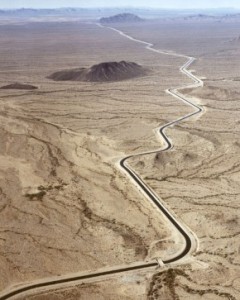 On Monday and Tuesday, April 27th and 28th, representatives of the American Security Project visited Phoenix, Arizona for a series of meetings, public events, and briefings on how climate change is affecting security, how institutions in the region are planning for it, and how that will impact the careers of military and civilians working on national security in the future. Attending were Attending were LtGen John “Glad” Castellaw, USMC (ret.) and Brig. General Steve Cheney, USMC (ret.). Castellaw was a 36 year veteran of the Marine Corps and now serves as the Director of the Crockett Policy Institute and a member of the ASP Board. Cheney is ASP’s CEO. Andrew Holland, ASP’s Senior Fellow for Energy and Climate participated as well.
On Monday and Tuesday, April 27th and 28th, representatives of the American Security Project visited Phoenix, Arizona for a series of meetings, public events, and briefings on how climate change is affecting security, how institutions in the region are planning for it, and how that will impact the careers of military and civilians working on national security in the future. Attending were Attending were LtGen John “Glad” Castellaw, USMC (ret.) and Brig. General Steve Cheney, USMC (ret.). Castellaw was a 36 year veteran of the Marine Corps and now serves as the Director of the Crockett Policy Institute and a member of the ASP Board. Cheney is ASP’s CEO. Andrew Holland, ASP’s Senior Fellow for Energy and Climate participated as well.
In Arizona, Climate change is likely to make droughts in the region longer, more intense, and more unpredictable – similar to other drylands regions around the world. The success, thus far, of development in the Arizona desert, where water use is down, even as the population continues to grow, can prove a model for drylands around the world. However, some climate effects could become too extreme, and simply cannot be adapted to; if there is not enough water, the region could face significant changes in the future.
The first event was a legislative round table over lunch, where ASP presented their briefing about the effects of climate change on security around the world, and then particularly focused on the threats and opportunities for the desert region of Arizona. Attending was a small, but influential group of about 10 staff members from Congressional offices, including Senator McCain’s, and the Mayor of Phoenix’s director of sustainability.
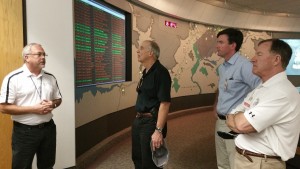 Following the round table, ASP representatives drove to the headquarters of the Central Arizona Project, one of the country’s largest water transfer projects. It draws water from Lake Havasu on the Colorado River, and sends it across Arizona to Phoenix and Tucson. Without this project, completed in the 1980s, the rapid growth of the Phoenix region would not have been possible.
Following the round table, ASP representatives drove to the headquarters of the Central Arizona Project, one of the country’s largest water transfer projects. It draws water from Lake Havasu on the Colorado River, and sends it across Arizona to Phoenix and Tucson. Without this project, completed in the 1980s, the rapid growth of the Phoenix region would not have been possible.
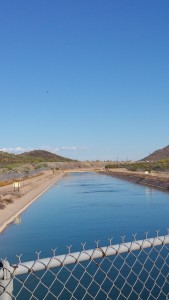 They discussed how the region has dealt with a drought lasting for 14 years. They showed how the technology of the CAP has allowed Arizona to conserve water, relative to states like California, where up to a third of the state’s distributed water is lost in transfer. In Arizona, less than 1% of water is lost. ASP representatives argued, as written in ASP’s paper “Water Management in the American Southwest” that three key adaptations to the dry, unpredictable climate in Arizona have allowed the region to continue to thrive: (1) a Clear Legal System for Water Rights, (2) a Regulatory Framework for Managing Water and (3) Investments in Infrastructure for Water Utilization. These three characteristics of water management can provide a model for adaptation for the rest of the world in a future of unpredictable climate change. Ultimately, however, some climate effects simply cannot be adapted to; if there is not enough water, all the legal rights, regulatory oversight, or poured concrete cannot distribute nothing.
They discussed how the region has dealt with a drought lasting for 14 years. They showed how the technology of the CAP has allowed Arizona to conserve water, relative to states like California, where up to a third of the state’s distributed water is lost in transfer. In Arizona, less than 1% of water is lost. ASP representatives argued, as written in ASP’s paper “Water Management in the American Southwest” that three key adaptations to the dry, unpredictable climate in Arizona have allowed the region to continue to thrive: (1) a Clear Legal System for Water Rights, (2) a Regulatory Framework for Managing Water and (3) Investments in Infrastructure for Water Utilization. These three characteristics of water management can provide a model for adaptation for the rest of the world in a future of unpredictable climate change. Ultimately, however, some climate effects simply cannot be adapted to; if there is not enough water, all the legal rights, regulatory oversight, or poured concrete cannot distribute nothing.
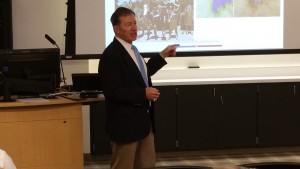 The following day, ASP members traveled to Tempe, the home of Arizona State University, for a meeting with the faculty of the ASU Global Security Initiative. The meeting included over 25 faculty from across the campus, ranging from an expert on climate negotiations, to experts on cybersecurity, to experts on sustainable energy. At the meeting, which was held under Chatham House rules, ASP and the faculty members exchanged ideas and views about how to build global security while also addressing climate change and the other major problems we face. This was one of the most interesting meetings of the tour, because it directly engaged with a group of people working deeply on this issue already.
The following day, ASP members traveled to Tempe, the home of Arizona State University, for a meeting with the faculty of the ASU Global Security Initiative. The meeting included over 25 faculty from across the campus, ranging from an expert on climate negotiations, to experts on cybersecurity, to experts on sustainable energy. At the meeting, which was held under Chatham House rules, ASP and the faculty members exchanged ideas and views about how to build global security while also addressing climate change and the other major problems we face. This was one of the most interesting meetings of the tour, because it directly engaged with a group of people working deeply on this issue already.
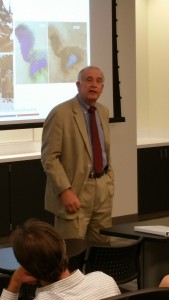 Following this meeting, ASP held a public event hosted by the ASU Global Security Initiative. The event drew over 40 students, faculty, and community members to the discussion. After their presentations, there was important questions and answers from the audience, particularly about the threats to Arizona. ASU has developed a strong role as a leader in sustainability, so many of the questions focused around clean energy deployment.
Following this meeting, ASP held a public event hosted by the ASU Global Security Initiative. The event drew over 40 students, faculty, and community members to the discussion. After their presentations, there was important questions and answers from the audience, particularly about the threats to Arizona. ASU has developed a strong role as a leader in sustainability, so many of the questions focused around clean energy deployment.
The final stop of the tour was a meeting with ASU office of sustainability, called “ASU LightWorks.” ASP met with staff and faculty from the office, who detailed how ASU is seeking to become a leader in sustainable energy, especially solar panels. ASU LightWorks envisions a resilient and equitable energy future supported by innovations in technology, policy, law and markets. They explained how ASU will support a series of energy-related research projects intended to engage veterans or active-duty military in the issue.





